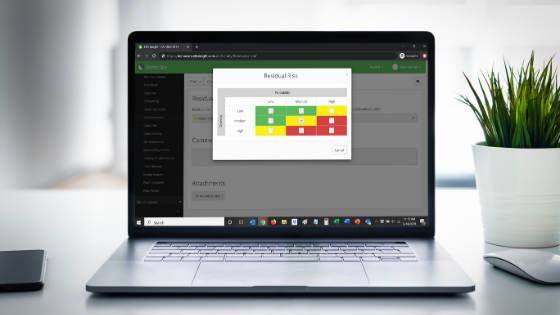How do you score risk? For safety professionals, this is a more common concern than most people realize, as it directly reflects their ability to assess acceptable versus unacceptable risk.
A risk management matrix is a simple, yet effective tool to help EHS professionals give an objective assessment of risk and make the appropriate recommendations to help their organizations prosper.
What is a risk management matrix, and how can you use it to support your business? Here’s what your team needs to know.
What Is a Risk Management Matrix?
A risk management matrix, more commonly known as a risk matrix, is a safety tool used to assess various workplace hazards. They’re a workplace safety standard allowing EHS professionals to score risks as part of the risk assessment process.
The simplest risk matrix is a 3×3 risk matrix, which has nine squares in total. On the X-axis is severity, and on the Y-axis is probability, or vice versa, depending on your preferences.
Scoring a Risk Matrix
Regardless of how you set up your axes, a risk matrix is set up so that you can score a risk on a scale of both severity and probability, thus assessing in concrete terms how significant the risk is.
A 3×3 severity axis contains the following values:
- Marginal (the hazard can be controlled or would result in less than minor injury, illness, or system damage)
- Moderate (the hazard will commonly cause severe injury, illness, or system damage)
- Critical (the hazard will likely cause death or major system loss)
Moderate severity risks require immediate corrective action, while critical risks require the immediate cessation of unsafe activities.
A 3×3 probability axis contains the following values:
- Improbable (unlikely to occur during standard operations)
- Occasional (likely to occur at some point during standard operations)
- Probable (likely to occur often during standard operations)
By multiplying a hazard’s probability and severity values, you can calculate the relative acceptability of risks.
How Safety Professionals Use Risk Matrices
In a perfect world, you could eliminate all risk to fully protect your workers from harm. However, that isn’t possible in the real world – some level of risk is necessary for business gains. If anything, the risk-reward relationship states it is impossible to achieve gains without some risk.
As such, the goal of risk management is to help determine and maintain an acceptable level of risk. The data retrieved can then be used to find new strategies to eliminate safety risk.
Risk management matrices are designed to help professionals assess what risks are worth taking based on the relative harm and the likelihood of that harm occurring. That way, you can forge ahead with risks that your business needs to succeed and eliminate unacceptable risks.
Smarter Risk Assessments, One Day at a Time
A risk management matrix is all about assessing your risks so that you can take appropriate steps toward managing them. For everything that comes after, we’re here to help, with safety software that’s designed to help your team respond to your biggest safety concerns.
Want to see how our software can complement your risk assessment process? Get in touch today to learn more.
